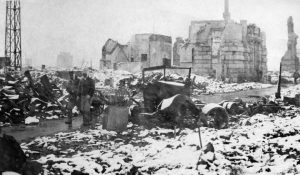Documenting Hiroshima of 1945: Mid-December, snow falls on charred ruins amid shortages of provisions and fuel
Dec. 19, 2024
by Minami Yamashita, Staff Writer
In mid-December 1945, snow fell on Hiroshima City, with its sprawl of charred remains after the atomic bombing. According to the Chugoku Shimbun newspaper published at the time, the first snowfall of the year fell on December 11, in line with typical years, with 1.3 centimeters of snow accumulating on December 18. The lowest temperature recorded during the period December 17–18 was a very cold -1.8 degrees Celsius, compared with the average temperature at that time of year of 1.6 degrees Celsius.
A Chugoku Shimbun article dated December 19 reported on the snowfall and called for, “Those living in shacks to make efforts to fully prepare for the onset of full-fledged winter.” However, supply shortages were severe. On the same day, under the headline “Voices of 1,000 war victims,” the newspaper carried the results of a survey of 1,000 people in Hiroshima, including government workers, company employees, school teachers, students, and housewives.
To a survey question asking, “What do citizens want now?” the largest ratio of respondents (28 percent) answered, “Increased supplies of staple foods.” At that time, people throughout Japan were suffering from food shortages because of poor rice crops and the return of demobilized soldiers and others repatriated from overseas, which led to delays in or cancellation of supplies of food staples.
That response was followed by “Mitigation of transportation issues” (14 percent) concerning traffic, and “Supply of firewood and charcoal” (11 percent) as fuel for warmth. With respect to education, respondents answered, “Development and restoration of school facilities” (9 percent) and “Magazines, textbooks, and other books” (5 percent). Other responses included, “Distribution of clothing, as well as bedding, shoes and umbrellas” (8 percent), “Timely construction of temporary housing” (6 percent), and “Establishment of movie theaters and other entertainment facilities” (6 percent).
The survey inquired if people believed that, “Famine will come,” with 86 percent of the respondents answering, “Famine is inevitable.” The article described the situation facing the war victims and called on the government to take corrective action. “The current state of the war victims is that there is no one they can rely on, with everyone living in shacks losing faith in the government, believing that ‘the authorities are completely unreliable.’”
(Originally published on December 19, 2024)
In mid-December 1945, snow fell on Hiroshima City, with its sprawl of charred remains after the atomic bombing. According to the Chugoku Shimbun newspaper published at the time, the first snowfall of the year fell on December 11, in line with typical years, with 1.3 centimeters of snow accumulating on December 18. The lowest temperature recorded during the period December 17–18 was a very cold -1.8 degrees Celsius, compared with the average temperature at that time of year of 1.6 degrees Celsius.
A Chugoku Shimbun article dated December 19 reported on the snowfall and called for, “Those living in shacks to make efforts to fully prepare for the onset of full-fledged winter.” However, supply shortages were severe. On the same day, under the headline “Voices of 1,000 war victims,” the newspaper carried the results of a survey of 1,000 people in Hiroshima, including government workers, company employees, school teachers, students, and housewives.
To a survey question asking, “What do citizens want now?” the largest ratio of respondents (28 percent) answered, “Increased supplies of staple foods.” At that time, people throughout Japan were suffering from food shortages because of poor rice crops and the return of demobilized soldiers and others repatriated from overseas, which led to delays in or cancellation of supplies of food staples.
That response was followed by “Mitigation of transportation issues” (14 percent) concerning traffic, and “Supply of firewood and charcoal” (11 percent) as fuel for warmth. With respect to education, respondents answered, “Development and restoration of school facilities” (9 percent) and “Magazines, textbooks, and other books” (5 percent). Other responses included, “Distribution of clothing, as well as bedding, shoes and umbrellas” (8 percent), “Timely construction of temporary housing” (6 percent), and “Establishment of movie theaters and other entertainment facilities” (6 percent).
The survey inquired if people believed that, “Famine will come,” with 86 percent of the respondents answering, “Famine is inevitable.” The article described the situation facing the war victims and called on the government to take corrective action. “The current state of the war victims is that there is no one they can rely on, with everyone living in shacks losing faith in the government, believing that ‘the authorities are completely unreliable.’”
(Originally published on December 19, 2024)








